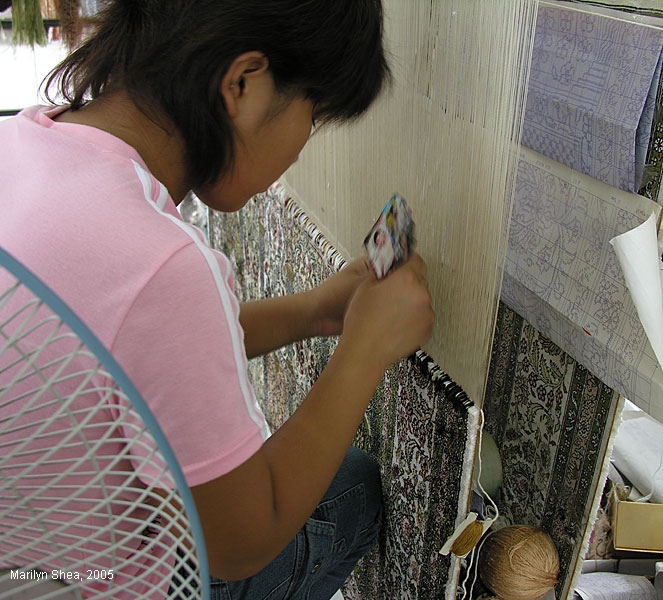 |
| This girl is demonstrating the ancient art of hand tied silk carpets. The most elaborate designs will use over a hundred different colors, but that is exceptional. Most designs require 6 to 10 colors to create pattern, shading, and depth. The pattern behind her work is marked off in grids to make counting easier.
The textile industry has been a driving force in Shanghai for hundreds of years. During the Yuan Dynasty (1271-1368), Shanghai grew into a shipping port, but it was during the Ming Dynasty (1368-1644) that the textile industry developed and quickly became the leading producer in China. That development, in turn, fueled the development of trade with other regions, and Shanghai began to be used as the commercial center between the north and south. The Grand Canal, connecting the Yangtze in Shanghai and the Yellow River in the north near Beijing and Tianjin, made it the natural hub. Its own textiles were shipped both north and south providing a customer base on which to expand. In 1685, during the Qing Dynasty, the Emperor Kangxi set up a customs house in Shanghai. By that time grains had become one of the most important products passing through Shanghai. Shanghai sits in the middle of the "bread basket", the most fertile area of farmland in China. When the British forced concessions on China, they moved into a busy, active port and added international trade with Europe to the mix. In 2006, the textile industry as a whole exported about $116 billion. Most of that was in clothing, but household textiles command a respectable share. In 2005, the European Union and the United States negotiated strict limitations on the number of Chinese textile imports. The Chinese distribute about 80% of these quotas based on past market share and put the rest up for bid. The bidding is competitive. From 2001 to 2005, the number of Chinese exporters rose from 21,099 to 65,000 (Xinhua News Service). |
China Index >> Shanghai, Bund, and Pudong >> Shanghai Textile Industry
Click on a picture or use the arrows at the top to navigate through the site.
http://hua.umf.maine.edu/China/shanghai2.html
Last update: February 2007
© Marilyn Shea 1996, 1999, 2002, 2007